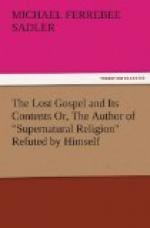“Even taking the representation of miracles, therefore, which Divines themselves give, they are utterly incompetent to perform their contemplated functions. If they are super-human, they are not super-Satanic, and there is no sense in which they can be considered miraculously evidential of anything.” (Vol. i. p. 25)
Now, this difficulty is the merest theoretical one,—a difficulty, as the saying is, on paper; and never can be a practical one to any sincere believer in the holiness of God and the reality of goodness. Take the miracle of miracles, the seal of all that is supernatural in our religion, the Resurrection of Christ. If there be a conflict now going on between God and Satan, can there be a doubt as to the side to which this miracle is to be assigned? It is given to prove the reality of a Redemption which all those who accept it know to be a Redemption from the power of Satan. It is given to confirm the sanctions of morality by the assurance of a judgment to come. If Satan had performed it, he would have been simply casting out himself. If this miracle of the Resurrection be granted, all else goes along with it, and the children of God are fortified against the influence, real or counterfeit, of any diabolical miracle whatsoever.
The miracles of the New Testament are not performed, as far as I can remember, in any single instance, to prove the truth of any one view of doctrinal Christianity as against another, but to evidence the reality of the Mission of the Divine Founder as the Son of God, and “the Son of God was manifested that He might destroy the works of the devil.”
2. With respect to what are called ecclesiastical miracles, i.e. miracles performed after the Apostolic age, the author of “Supernatural Religion” recounts the notices of a considerable number, assumes that they are all false, and uses this assumed falsehood as a means of bringing odium on the accounts of the miracles of Christ.
More particularly he draws attention to certain miracles recorded in the works of St. Augustine, of one at least of which he (Augustine) declares he was an eye-witness.
Now, the difficulty raised upon these and similar accounts appears to me to be as purely theoretical as the one respecting Satanic miracles. If there be truth in the New Testament, it is evident that the Founder of Christianity not only worked miracles Himself, but gave power to His followers to do the same. When was this power of performing miracles withdrawn from the Church? Our Lord, when He gave the power, gave no intimation that it would ever be withdrawn, rather the contrary. However, even in Apostolic times, the performance of them seems to have become less frequent as the Church became a recognized power in the world. For instance, in the earlier Epistles of St. Paul the exercise of miraculous gifts seems to have been a recognized part of the Church’s system, and in the later ones (1 and 2 Timothy and Titus) they are scarcely noticed. [164:1] If we are to place any credence whatsoever in ecclesiastical history, the performance of miracles seems never to have ceased, though in later times very rare in comparison with what they must have been in the first age.




